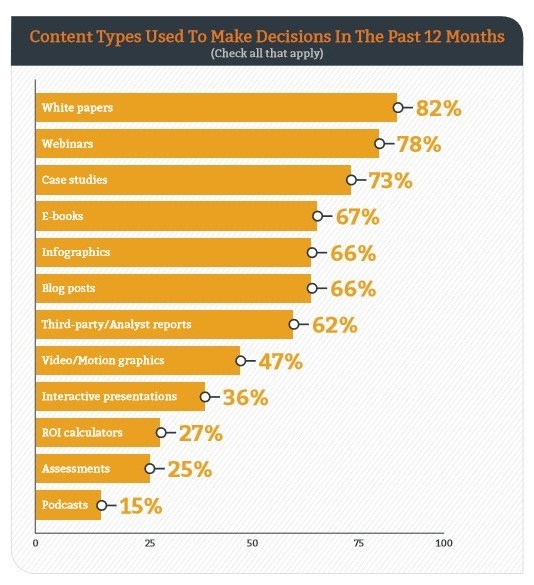7 Compelling Reasons to Publish a White Paper
White papers have been used routinely for decades by business people in industries like technology, logistics, healthcare and manufacturing. They like them because they help them make high-ticket purchase decisions.
Quite right, too. But there are many more genuine reasons for developing a white paper, some of which may surprise you...

1. White papers boost your Google rankings and generate leads
What’s the best way to improve your search-engine results and click-through rate? It’s to publish relevant content. Quality content is, without a doubt, the number one driver of your search-engine rankings.
But how do you define quality content?
It’s got to be well written, of course. Business people have neither the time nor patience to read poorly constructed articles. But quality content is much more than perfect grammar and high readability scores. It’s got to be relevant, and it needs to relieve a pain point common to your customers and prospects.
White papers are the perfect example of quality content because they don’t sell to people, they help them. They provide useful information for business people seeking to understand an issue, solve a problem or make a decision.
In other words, your target audience is already on the internet looking for an answer to their quandary. And they’re looking for your help.
SEO tip
Maximize your chances of rising through the Google ranks by making sure your white paper addresses a common industry-wide problem (one that keeps your customers awake at night) and includes targeted keywords in the title and throughout the document.
2. White papers increase your brand awareness
Building your brand is all about getting prospective buyers to recognize the existence and availability of your product or service. A key part of the brand awareness process is marketing your branded content.
After all, there’s no point creating content if no one is going to read it.
Or share it.
The sharing of content has soared with the help of social media platforms like Facebook, LinkedIn and Google+. They open doors wide to the corporate decision makers you’re yearning to be introduced to.
But to get that introduction you must be creating the right type of content. The most shareable type of content.
And white papers are the content most likely to be shared with colleagues.
Yep, white papers come top with 79% of B2B buyers. Webinars and infographics come second and third at 68% and 67% respectively.
These statistics from Demand Gen Report’s 2016 Content Preferences Survey tell us that the most shareable type of content is educational content.
An overwhelming majority (96%) of B2B buyers want content with more insight from industry thought leaders and analysts. In other words, content that engages and informs, rather than sells.
Demand Gen Report’s 2016 Content Preferences Survey
3. White papers meet your buyers' demand for well-written, useful information
In 2016, 51% of B2B buyers relied more on content to research their buying decisions compared to the year before, and almost half of B2B buyers read three to five pieces of content before contacting a salesperson (16% read seven or more pieces).
That may not surprise you.
These days, most of us go online to check out reviews and compare prices before we spend our hard-earned money.
What may well surprise you is this: white papers are the form of content most relied on to make a purchase decision.

Content used by B2B buyers in 2016 to make their purchasing decisions,
according to Demand Gen Report’s 2016 Content Preferences Survey
So, if you thought white papers were old hat, think again.
It seems buyers are being turned off by too much hype. They’re rejecting long-form content with a heavy sales pitch in favor of content that can help them benchmark their strategies and learn about the successes of others in their industry.
It’s clear that - if you promote white papers widely and effectively - they still have a major role in capturing leads and nurturing prospects through the buying process.
4. White papers can be used to educate your channel partners
If your company works with value-added resellers, managed service providers, consultants, original equipment manufacturers and distributors, it’s almost definitely providing them with some sort of access to product and marketing training.
After all, the more product knowledge your channel partners have, the more they’ll achieve.
White papers make an excellent contribution to any partner education program. Highly accessible, and certainly more engaging than a manual, they provide practical information to those helping you meet your sales targets.
Of course, it’s not only channel partners who need to be educated about your latest product or service. You sales force does, too. And let’s not forget journalists and trade publishers and other interested parties.
The role of the white papers isn’t limited to cultivating buyers.
5. White papers can help you cast doubt on your competitors' solutions
One of the best aspects of well-written white papers is how they gently lead the reader to the right conclusion (that your solution will solve their problem) after going through and dismissing all the traditional, alternative solutions offered by your competitors.
You can’t resort to marketing speak and exaggerated claims in a white paper, of course. You have to use facts and logic to build a sound argument, appear unbiased and produce the evidence.
But, by pointing out the flaws of all the other solutions, a white paper can position your company as the one offering the better solution.
6. White papers can be repurposed to maximize your marketing budget
Take one white paper and turn it into several promotional items with minimum effort. Yes, you can stretch your white paper investment by reusing your document as a basis for different marketing purposes.
Here are a few recycling ideas for you:
- Make a slide deck and post to your website and platforms like YouTube and SlideShare
- Develop a webinar and offer a training session to sales reps and channel partners
- Write one or more blog posts by shortening the intro and close and pruning the narrative
- Design an infographic using the best facts, quotes and figures and post to social media channels
- Ask B2B periodicals, websites and trade magazines to publish the paper as a placed article
7. White papers can be shaped into engaging, interactive content to separate you from the crowd
Admittedly, the format of most white papers is still many paragraphs of text interspersed with a few graphics.
While the continued popularity of white papers is not in dispute, they could perhaps benefit from being a little more engaging.The millennials among your customer base would certainly appreciate an upgrade.
With a little bit of creativity, you can turn your white paper into a multimedia PDF. Throw in some audio, one or more videos, and perhaps even a test or quiz to make it interactive. Or why not try a tabbed approach to make your content easier to scan?
There are many ways you can engage your audience with interactive content. White papers don’t have to remain stuck in the 20th century, and they certainly shouldn’t be as dull as dish water.
Interactive content will not only give your white paper a fresh, modern look but also help your readers digest a lot of information.
So, there are my seven reasons for publishing white papers. Pretty convincing, eh? If you're thinking of publishing a white paper for your company, take a couple of minutes to check out my white paper writing service and my white paper planning service. You could soon be enjoying all these benefits too!

